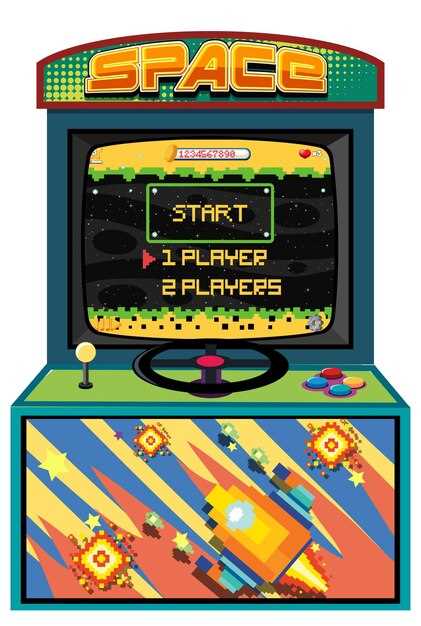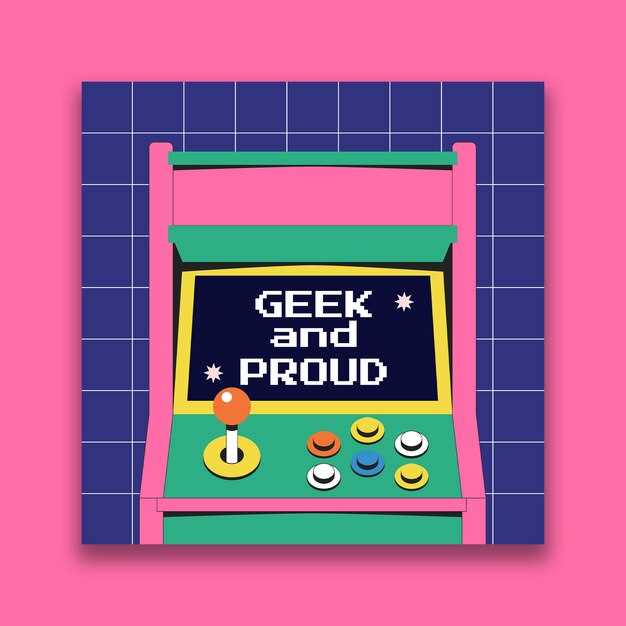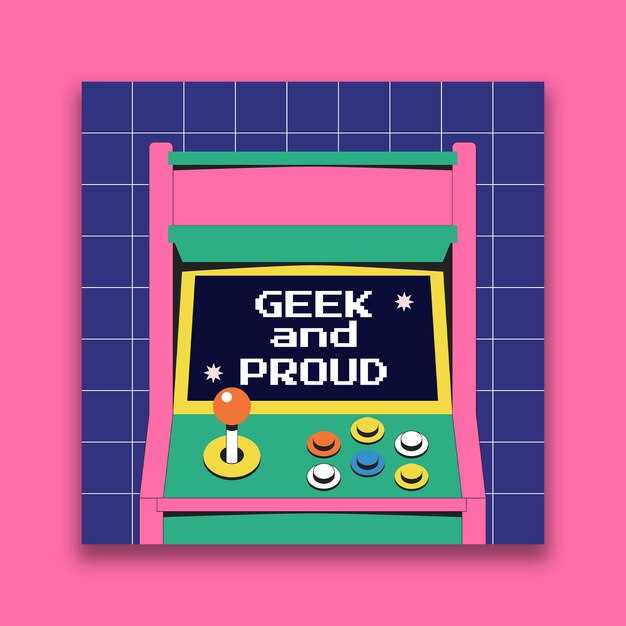To truly appreciate retro arcade game mechanics on mobile platforms, immerse yourself in the simplicity of controls paired with engaging gameplay. Retro games rely on straightforward mechanics that create an addictive experience, often achieved through quick reflexes and intuitive design. Games like “Pac-Man” and “Space Invaders” exemplify how minimalistic approaches can deliver maximum enjoyment.
Focus on control responsiveness. The transition from physical joysticks to touchscreen controls presents unique challenges. Many successful mobile adaptations incorporate touch gestures that mirror the original mechanics. For instance, utilize swipe actions to replicate classic movement paradigms, making it easier for players to reconnect with their nostalgic favorites.
Think about game pacing. Retro games often feature a gradual increase in difficulty, hooking players while providing a rewarding challenge. Maintain this principle by scaling levels effectively, ensuring that players feel a sense of achievement as they progress. This pacing encourages them to return for more, as they strive to master each level.
Lastly, integrate high-score systems. Competition drives engagement; preserving the leaderboard aspect from the original arcade experience will captivate players. Highlight their achievements and foster a community where they can compare scores, sharing tips and strategies. With these elements in place, retro arcade games will continue to thrive in the mobile format, captivating new generations of gamers.
How Classic Game Design Influences Mobile Gameplay

Classic game design principles shape mobile gameplay significantly. Developers incorporate simple mechanics that prioritize user engagement. For instance, one-touch controls derived from arcade classics ensure intuitive gameplay. Designers focus on short session times, allowing players to enjoy quick matches that align with mobile usage patterns.
Mechanics That Resonate
Many features of classic games translate seamlessly into mobile formats. Consider the following aspects:
| Classic Mechanic | Mobile Adaptation |
|---|---|
| High Score Pursuit | Leaderboard integration encourages competitive play, driving replayability. |
| Level-Based Progression | Short, digestible levels allow players to make quick progress while on the go. |
| Power-Ups | Mobile games utilize power-ups to enhance gameplay and add strategic depth. |
| Pixel Art Style | Nostalgic graphics appeal to players, creating a sense of familiarity and comfort. |
Community and Social Engagement
Building a community around games mirrors classic arcade culture. Mobile games often feature social sharing tools, inviting friends to compete. This encourages a sense of camaraderie reminiscent of early gaming experiences. Users engage through challenges and events, maintaining sustained interest in the game.
By infusing mobile games with these timeless design principles, developers keep players returning, tapping into the nostalgia while ensuring modern gameplay remains fresh and exciting.
Key Arcade Game Mechanics That Resonate with Today’s Players

Classic arcade mechanics make a strong impression on modern gamers. One such mechanic is simple controls, which promote accessibility and immediate enjoyment. Touch controls on mobile devices can replicate the feel of joystick movements, allowing players to easily engage with gameplay without a steep learning curve.
High Score Chasing
The thrill of competing for high scores drives many players. Displaying leaderboards fosters competition among friends and online communities. Incorporating score multipliers or bonuses encourages players to improve and play repeatedly, enhancing their overall satisfaction. Integrating social sharing features lets players showcase their achievements, further fueling their desire to compete.
Reward Systems
Modern players appreciate reward systems that provide a sense of progression. In-game achievements, unlockable characters, or power-ups create milestones that motivate continued play. Regular challenges or limited-time events can keep engagement levels high. Implementing rewards for daily logins or in-game tasks enhances player loyalty and creates a habit-forming experience.
Adapting Retro Graphics for Modern Mobile Devices
To adapt retro graphics for mobile, prioritize crisp pixel art. Use higher resolutions while maintaining the pixelated charm. Scale sprites correctly, preserving their iconic look without blurriness. Tools like Aseprite or Photoshop allow flexibility in creating and editing pixelated assets for different screen sizes.
Aspect Ratios and Screen Sizes
Consider various aspect ratios of mobile devices. Design your graphics for a 16:9 aspect ratio as a baseline, but ensure scalability for other ratios. Create adaptable UI layouts to maintain consistent user experience across devices. Use vector graphics where possible for icons, as they resize without loss of quality.
Color Palettes and Visual Style
Select color palettes that evoke nostalgia but enhance vibrancy for modern displays. Use tools like ColourLovers to generate appealing palettes reminiscent of classic games. Experiment with layering effects–shadows and highlights can add depth while keeping the retro aesthetic intact. Limit your selection to a small color set for authenticity, maintaining strong contrasts to improve visibility on mobile screens.
The Role of Level Progression in Engaging Players
Incorporate a tiered level progression system to keep players motivated. Each level should introduce unique challenges, mechanics, or environments to maintain interest. Gradually increasing difficulty encourages players to refine their skills while providing a clear sense of achievement.
Implement periodic rewards for leveling up, such as new abilities, power-ups, or cosmetic upgrades. These incentives not only enhance gameplay but also give players a tangible reason to strive for the next milestone. Balance the timing of rewards to prevent feelings of frustration or boredom.
Consider integrating branching paths within level progression. Allow players to choose their route or objectives, creating a personalized experience. This approach caters to different playing styles, making the game more appealing to a wider audience.
Utilize checkpoints effectively to reduce the stress of failure. When players know they can respawn near where they left off, they’re more likely to experiment and take risks without the fear of starting over from the beginning.
Monitor player feedback regarding level pacing and adjust difficulty spikes accordingly. Regular updates based on player data can enhance engagement, ensuring that content remains relatable and enjoyable for both novice and experienced players.
Lastly, integrate narrative elements tied to level progression. A compelling storyline that unfolds alongside gameplay can immerse players deeper, encouraging them to pursue the next level for both challenge and story development.
Balancing Difficulty: Lessons from Retro Games
Implement gradual progression in difficulty. Retro games often start easy, allowing players to build skills before introducing more challenging levels. This approach keeps frustration at bay while promoting engagement.
- Start with simple mechanics. Introduce one or two core gameplay elements initially, letting players master them before adding complexity.
- Use predictable patterns. Enemies and obstacles should follow recognizable behaviors, enabling players to anticipate challenges and react accordingly.
Incorporate strategic difficulty spikes. Create moments that significantly increase tension, making sure to balance them with easier sections that provide relief. This pattern helps maintain player interest without overwhelming them.
- Design boss battles as memorable highlights. These encounters should challenge players while still feeling fair, reinforcing the skills they’ve developed throughout the game.
- Introduce power-ups and rewards strategically. Providing players with tools or abilities at key moments can aid in overcoming challenging sections without diminishing the sense of achievement.
Solicit player feedback for fine-tuning. Engage with your audience to understand their experience and refine difficulty levels. Players can offer insights on specific areas that may need adjustment.
Apply retro-inspired save systems. A balance between punishing failures and rewarding persistence encourages players to attempt challenging sections without the fear of losing significant progress.
- Implement checkpoints in strategic locations.
- Enable a practice mode for players to experiment without pressure.
Focus on replayability. Incorporate alternate paths or multiple difficulty settings. This approach allows players to revisit the game, enhancing their skills and exploring new strategies.
Exploring Popular Retro Game Genres in Mobile Formats
Racing games bring thrilling speed to mobile users. Titles like “OutRun” and “Pole Position” transition smoothly into touch controls, allowing players to drift around corners with simplicity. Look for apps that feature tilt steering or simple tap controls for an authentic experience.
Platformers
Platformers remain a fan favorite. Classic elements from games like “Super Mario Bros.” find their way into mobile adaptations. Many modern titles adopt straightforward jump mechanics and collectible items. Check out games that offer responsive controls for seamless gameplay. The addition of touch gestures enhances jumping, running, and interacting with obstacles.
Puzzle Games
Puzzle genres shine in mobile formats, with games like “Tetris” and “Dr. Mario” seeing successful adaptations. Simple mechanics allow for quick play sessions, fitting well into mobile devices. Look for titles that incorporate unique twists, such as combining mechanics from various classic games. This keeps the gameplay fresh while retaining its retro charm.
| Genre | Recommended Titles | Control Style |
|---|---|---|
| Racing | Asphalt 9, Hill Climb Racing | Tilt or tap |
| Platformers | Super Retro Land, Rayman Adventures | Touch gestures |
| Puzzle | Puyo Puyo Champions, TETRIS® | Tap and swipe |
Exploring these popular genres highlights the adaptability of retro games. Mobile adaptations preserve the essence of the originals while introducing playful controls. Seek out your favorites and enjoy a nostalgic gaming experience no matter where you are.
Game Monetization Strategies for Retro-Inspired Titles
Implementing a combination of in-app purchases, advertisements, and premium pricing models maximizes revenue for retro-inspired games. Start by offering a free version with essential features that entice players. This method allows users to explore the game without commitment, increasing the initial player base.
In-App Purchases (IAP)
Introduce cosmetic upgrades or new character skins as in-app purchases. Retro titles thrive on nostalgia, so tying these purchases to classic aesthetics appeals to fans. Limited-time offers and seasonal skins can create urgency and boost sales. Additionally, consider offering power-ups or extra lives that enhance gameplay, allowing players to advance more smoothly through challenging levels.
Advertisements and Subscription Models
Integrate advertisements in a non-intrusive manner. Rewarded ads can offer players bonuses for watching, enhancing user experience while generating income. For dedicated players, a subscription model ensures access to exclusive content or an ad-free experience. This approach caters to both casual gamers and hardcore enthusiasts, providing flexibility in how they choose to engage with your title.
Engaging Sound Design Inspired by Classic Arcade Games
Use chiptune music to create an energetic atmosphere. This genre captures the essence of classic arcade games, utilizing simple melodies and catchy rhythms that resonate with nostalgia. Incorporate looping tracks that evoke excitement without becoming distracting. Adjust tempo based on gameplay intensity to enhance the player’s emotional engagement.
Implement sound effects that mimic those from retro games–bleeps, bloops, and bursts of energy effectively convey actions such as jumping, collecting items, or defeating enemies. Layer sounds to add depth, enhancing the sensation of immersion. For instance, combine sound effects for character movement with background noise to mimic an engaging arcade environment.
Add Variety with Genre-Specific Effects
Tailor sound design to suit different game genres. For platformers, emphasize jumps and landings with satisfying sound cues. In shooters, use impactful sounds for weapon firing and enemy explosions. Rhythm games benefit from synchronization, where sound effects align perfectly with user actions, creating a seamless experience.
Create Feedback and Rewards
Integrate auditory feedback for player actions. Rewarding sounds for achievements and milestones motivate continued play. Use a distinct sound for level completion or unlocking new features, creating memorable moments that resonate with players. This reinforces a sense of progression and accomplishment.
Player Interaction: Emulating Social Play in Mobile Games
Integrate real-time multiplayer functionalities to replicate the social aspects of retro arcade gaming. This feature allows players to engage directly with each other, creating a competitive atmosphere reminiscent of classic arcade halls. Consider using leaderboards and tournaments to fuel competition and enhance interaction.
Incorporate Social Features
Add elements such as chat systems or voice communication to foster community among players. Implementing friend lists encourages ongoing engagement and lets players connect with familiar faces. These interactions build camaraderie, reminiscent of the social play found in traditional arcades.
Utilize Asynchronous Gameplay
Design games that enable asynchronous interactions. Turn-based mechanics allow players to challenge each other without requiring simultaneous play. This flexibility attracts users with busy schedules, maintaining their interest while encouraging social play. Notifications about friends’ progress enhance the competitive edge.
Nostalgia as a Marketing Tool for Retro Mobile Games
Utilize nostalgia by incorporating familiar graphics and soundtracks from classic arcade titles. This invokes positive memories, drawing in players who fondly recall their childhood gaming experiences. Employ pixel art and chiptune music as these elements resonate well with the target audience.
Target Audience Engagement
Identify and engage the audience who grew up with retro games. Incorporate social media campaigns that highlight popular titles from the past. Encourage users to share their favorite memories and experiences related to those games, creating a sense of community and shared history.
- Run contests inviting players to upload their high scores, generating excitement and competition.
- Offer limited-time releases of games inspired by classic titles to capitalize on nostalgia.
Gameplay Mechanics and Features
Design gameplay mechanics that reflect the simplicity and challenge of retro games. Include power-ups, time limits, and leaderboards to appeal to competitive spirits. Introduce elements such as pixelated graphics, 8-bit sound effects, and straightforward controls to enhance the nostalgic experience.
- Focus on short play sessions to mimic arcade-style gaming.
- Implement a rewards system reminiscent of classic arcade games, granting virtual tokens for achievements.
- Integrate cooperative or competitive multiplayer options to encourage social interaction.
Highlight these features in marketing materials to attract players who miss the arcade culture. Use influencers and nostalgia-oriented channels to promote the game, tapping into the emotional connections people have with their past gaming experiences.
Comparing Control Schemes: Touch vs. Classic Buttons
Choose touch controls for accessibility and intuitive gameplay. Players can swipe and tap on screens, making actions feel natural, especially for newcomers. Games like “Crossy Road” demonstrate how touch mechanics can facilitate quick responses and enhance player engagement.
Benefits of Touch Controls
- Simple Interaction: Minimal learning curve appeals to casual players.
- Dynamic Layout: Alter button placement or size based on player preference.
- Gestural Inputs: Utilize swipes or pinches for unique mechanics.
Advantages of Classic Button Controls
- Precision: Buttons provide tactile feedback, aiding in accuracy during gameplay.
- Consistency: Familiarity for players who grew up with arcade cabinets.
- Multi-Action Execution: Players can easily perform complex maneuvers under pressure.
Consider a hybrid approach. Some games incorporate both options, allowing players to switch based on personal preference. This flexibility enhances user experience and broadens engagement, catering to both casual and hardcore gamers. Ultimately, select the controls that match your gaming style and preferences.
How to Incorporate Easter Eggs and Secrets in Mobile Games
Create unique elements that surprise players and encourage exploration. Start by designing hidden areas or levels that only the most curious players can find. These can be visual cues or subtle changes in the environment that signal something special is nearby.
Integrate puzzles that require players to connect dots in unexpected ways. Use character dialogues or items that hint at hidden features without giving it all away. Offer diverse outcomes based on how players approach these challenges, enhancing replayability.
Consider including a variety of collectibles that serve dual purposes. Players enjoy finding items that contribute to their progress while also revealing background lore or leading to secret locations. Balance these items wisely to keep players engaged without making secrets feel forced.
Use the touch interface creatively to hide interactions. For instance, tapping specific locations on the screen could trigger hidden animations or dialogues. Small interactions like swiping or shaking the device can uncover new paths or items, making discovery feel organic.
Power-ups can also serve as Easter eggs. Create rare boosts or transformations that are difficult to obtain but offer unique gameplay experiences. This adds excitement and keeps players hunting for their next reward.
Encourage community engagement by allowing players to share their discoveries. Incorporate social features that enable users to post clues or hints for others. This fosters a community of explorers eager to exchange their findings.
Regularly update the game with new Easter eggs. Seasonal events or updates can reintroduce older secrets or add new layers, ensuring players continue to find surprises even after completing the main content.
Measure how players interact with the secrets you include. Analyze data on where players commonly search or frequently miss hidden elements. Use this information to refine future designs, enhancing the element of surprise and delight.
Video:
Arcade games and electronics repair basics
Arcade games and electronics repair basics by Cooking with Dr. Chill 64,630 views 7 years ago 45 minutes
Q&A:
What are the main differences in game mechanics between retro arcade games and modern mobile games?
Retro arcade games typically feature simpler mechanics focused on straightforward gameplay, high scores, and a limited number of controls. They often emphasize rapid reflexes and quick decision-making. In contrast, modern mobile games may incorporate complex mechanics, such as intricate narratives, character progression, and various control schemes utilizing touch screens. Many mobile games also integrate social features and online multiplayer elements, enhancing the gaming experience beyond what was possible in traditional arcade settings.
How have the graphics and audio in retro arcade games influenced modern mobile game design?
Retro arcade games are characterized by pixel art graphics and chiptune audio, which evoke nostalgia for many players. This aesthetic has been embraced in some modern mobile games, resulting in titles that prioritize simplicity and charm over high-end graphics. This influence can often be seen in indie games that aim to capture the essence of earlier gaming experiences while integrating more advanced technology like high-definition displays and immersive sound effects. The retro style allows these games to stand out in a market saturated with high-resolution titles.
Are there any successful mobile games that pay homage to classic arcade games?
Yes, several mobile games pay tribute to classic arcade titles. For example, games like “Pac-Man 256” build upon the mechanics of the original “Pac-Man,” adding modern twists like endless gameplay and power-ups. Similarly, “Crossy Road” takes inspiration from the classic “Frogger,” featuring simple controls and an emphasis on scoring while maintaining a retro aesthetic. These games capture the spirit of their predecessors while appealing to contemporary audiences with updated features and mechanics.
How do game developers maintain the balance between nostalgia and innovation in mobile games inspired by classic arcades?
Game developers often strive to create a blend of nostalgia and innovation by retaining core gameplay elements that made the original arcade games enjoyable while introducing new features that enhance the gaming experience. This can include modern graphics, new levels, or interactive social elements. Developers may also seek feedback from players familiar with the classics to ensure they appreciate the homage. Finding this balance allows developers to attract a wide audience, catering to both those who grew up with arcade games and new players looking for engaging gameplay.



